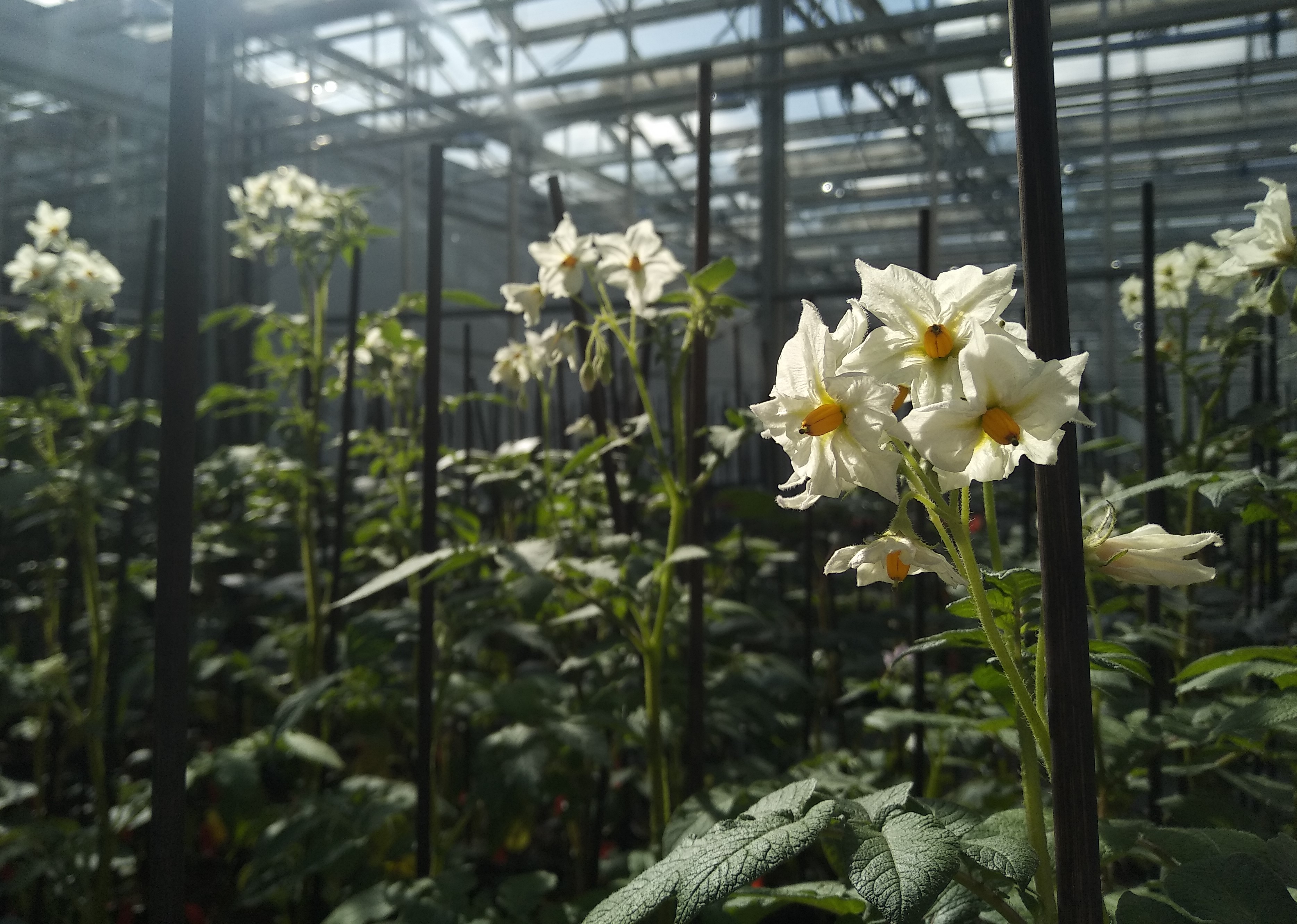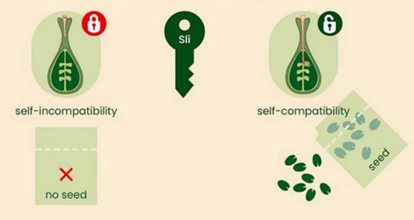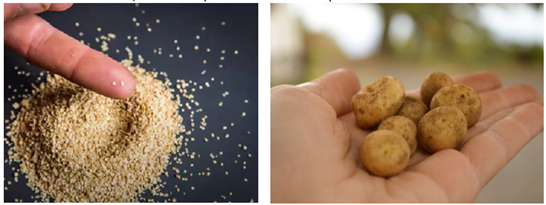Hybrid Potatoes – A Climate-Smart Solution for Potato Farmers

This post is also available in:
This post is also available in:
![]() Français (French)
Français (French) ![]() Deutsch (German)
Deutsch (German) ![]() Português (Portuguese (Brazil))
Português (Portuguese (Brazil))
Collaborators, colleagues, and supporters of the project: Lucia Sandra Perez Borroto, Lorena Gonzales Ramirez, Ernst-Jan Eggers Salome Prat, Maroof Ahmed-Shaikh.
The high importance of the potato crop worldwide does not depend only on the fact that it is the third most consumed crop after rice and wheat (FAO, 2014). The high energy content of the tubers, the simple cultivation technique of the crop, and the extensive geographical range of production areas have made potatoes an important food security crop, especially for developing countries and small farmers.
The wide diversity of the environmental conditions in the different cultivation regions creates the need to overcome the dependence of the tuberization from the photoperiod and also to develop varieties that are well adapted, climate-resilient, and resistant to a range of biotic stresses. This need becomes even more urgent nowadays under the effects of climate change, with increasing the stresses (especially abiotic) and requiring new cultivars to maintain yield stability.
Abiotic stresses and potato
Which are the most common abiotic stresses of potatoes?
One of the most frequent stresses that more and more potato growers face nowadays is the temperature rise. Potato plants are very sensitive to heat stress since they are considered cool-season crop. Elevated temperature (even moderate increases during tuberization) can inhibit the tuber formation causing severe yield penalties and internal and external quality reduction. The “heat sprout” phenomenon is quite common when the immature tubers are exposed to high temperatures, resulting in a decrease in the post-harvest (storage life) of the tubers (Zhang et al., 2021). On the other hand, low temperatures (below 0 °C) also pose a problem for the crop since it is frost sensitive in the early developmental stages. In addition to above ground damage of low temperatures, soil temperatures below 0°C will cause complete yield loss (Pino et al., 2007).
Despite its high Water Use Efficiency (WUE), potato is extremely sensitive to even slight water limitation leading to yield reduction. The reduced rainfall (precipitation), as one of the effects of climate change, is limiting production in arid regions without additional irrigation. Depending on the moment and the duration, drought stress can affect potato yield in various ways. During the vegetative stage, drought can affect photosynthesis and plant growth and cause leaf loss. Later, such stress can shorten the crop’s life cycle, reducing the number and size of tubers produced and their quality (Nazir & Toth., 2022). Moreover, potatoes are also relatively sensitive to salt stress, especially when cultivated in coastal regions. At the same time, flooding, even for a short period of time, can cause significant damage to the plants.
In order to address these demands, farmers and scientists have tried, for centuries, to ameliorate potato crops through breeding.
The complexity of potato genetics
The genetic improvement of potatoes in the past century has been modest, with old varieties like Bintje and Russet Bank remaining widely cultivated. The main limiting factor for this, is the complex genetics of potatoes with variation in ploidy levels between the species. Most cultivated varieties have four copies of the standard number of 12 chromosomes (2n=4x=48) (tetraploids). Due to this, breeding a new variety-cultivar and adding one extra trait with traditional techniques takes between 15-20 years.
What is Potato Hybrid Breeding?
What are the potato hybrids?
Scientists have experimented with hybrid potato breeding over the past few years to simplify and accelerate the creation of new potato varieties, with many promising results. The revolution comprises making potatoes diploids (having only 2 copies of chromosomes like tomatoes) and self-compatible. This allows the introduction of a new trait (characteristic) in only 3-4 years. At this point, it is important to clarify that potato hybrids are not by any means Genetically Modified Organisms.
Another big change accompanies this revolution. Like many other popular vegetables, hybrid potatoes can reproduce by using both the tubers (potato seeds) and the actual botanical seeds (True Potato Seeds) produced sexually. 
The key to unlock the hybrid breeding was a specific gene called “Sli”, which was responsible for restoring the self-compatibility to the potato plants (Eggers et al., 2021). That means that the potato plants having this gene, can be self-pollinated and produce seeds.

Hybrid potatoes open the door to the easier introduction of various genes of interest, aiming to improve the tolerance of plants to abiotic stresses. One of these genes is the StFLORE that the team of Christian Bachem at Wageningen University has lately focused on (Gonzales et al., 2021). Based on lab experiments, the plants that carried this gene not only grown more rapidly, but they were also more robust, even under drought stress, than the regular plant. The potato plants carrying the StFLORE gene had an improved underground root system as well.
The development of stress-tolerant potatoes at the “microscope” of the ADAPT project
The need to unravel the genes behind the stress-tolerance of potato plants led 10 leading academic research institutions, 4 potato breeders, a screening technology developer, a non-profit EU association and a government agency to create the ADAPT consortium (Accelerated Development of multiple-stress tolerAnt PoTato). This 5-year EU project (started in 2020) aims to develop new strategies to make potatoes fit for the challenging climatic conditions of the future, like combinatorial heat and drought stress, including flooding events resulting from heavy precipitation. The high practical relevance of the project is expected to benefit breeders, farmers and consumers.
We are lucky to have access to and use many technologies allowing very precise phenotyping of our plants. Among the cutting-edge technologies of the Netherlands Plant Eco-Phenotyping Centre (NPEC) that we use are the TraitSeeker and 3 drones with devices fitted with colour, thermal, 3D (LIDAR), and hyperspectral cameras, offering detailed phenotyping and crop performance (in-depth phenotyping).

The advantages of using Hybrid Potatoes and True Potato Seeds (TPS)
While there are still no hybrid potato varieties available on the market, scientists plan to release the first varieties in 2024. The hybrid breeding technology will open the door for creating new, improved potato varieties resistant to important potato diseases, higher nitrogen and water use efficiency, and superior quality characteristics. This will help farmers cope with the effects of climate change and cultivate more sustainably, reducing the use of phytochemicals.
Hybrid potatoes can be propagated by using the True Potato Seed (TPS) produced by the berries of the plants (above grounds) instead of the tubers (potato seeds) that all farmers currently use. Depending on the potato variety, a plant can produce 5 to 50 berries, each containing 50-150 seeds. These seeds are tiny, even smaller than tomato seeds, and only 25 grams of TPS (62,500 seeds) will be needed instead of 2,500 kilos of potato seed tubers to plant a one-hectare field. 
The transportation and handling of the seed potatoes (tubers) are the hardest and most energy-intensive due to the large size of the propagational material and its sensitivity. On the contrary, the TPS can be easily transported, reducing the carbon footprint of the production system. At the same time, it can be stored for much more extended periods without the need for special storage facilities. Another significant advantage for farmers is that this propagation material (TPS) is clean and diseases free.
While potato hybrids and True Potato Seed will be a great asset for all potato growers globally, it will have an even larger positive impact in low to middle-income countries (especially for sub-Saharan Africa), making transportation and storage simpler and safer for more extended periods. However, this will create the need to change how potato growers sow and treat their crops. There are actually a whole series of options for switching to TPS – these include:
- Sowing seed directly in the field,
- Pre-growing in seedling nurseries followed by field-planting and
- Growing seedlings in the first year to produce distributable ware potatoes. Probably the latter will be the system of choice as it does not require the farmer to retool.
This articles has been created based on the presentation of Dr. Bachem in the online webinar: Climate-Smart Agriculture.
References
Eggers EJ, van der Burgt A, van Heusden SAW, de Vries ME, Visser RGF, Bachem CWB, Lindhout P. Neofunctionalisation of the Sli gene leads to self-compatibility and facilitates precision breeding in potato. Nat Commun. 2021 Jul 6;12(1):4141. doi: 10.1038/s41467-021-24267-6. PMID: 34230471; PMCID: PMC8260583.
Hancock R, Morris W, Ducreux L, Morris J, Usman M, Verrall S, et al. Physiological, biochemical and molecular responses of the potato (Solanum tuberosum L.) plant to moderately elevated temperature. Plant Cell Environ 2014; 37(2):439-50
Nasir, M. W., & Toth, Z. (2022). Effect of drought stress on potato production: A review. Agronomy, 12(3), 635.
Pino, M.-T.; Skinner, J.S.; Park, E.-J.; Jeknić, Z.; Hayes, P.M.; Thomashow, M.F.; Chen, T.H. Use of a Stress Inducible Promoter to Drive Ectopic AtCBF Expression Improves Potato Freezing Tolerance While Minimizing Negative Effects on Tuber Yield. Plant Biotechnol. J. 2007, 5, 591–604
Ramírez Gonzales L, Shi L, Bergonzi SB, Oortwijn M, Franco-Zorrilla JM, Solano-Tavira R, Visser RGF, Abelenda JA, Bachem CWB. Potato CYCLING DOF FACTOR 1 and its lncRNA counterpart StFLORE link tuber development and drought response. Plant J. 2021 Feb;105(4):855-869. doi: 10.1111/tpj.15093. Epub 2021 Feb 11. PMID: 33220113; PMCID: PMC7985872.
Zhang, G., Tang, R., Niu, S. et al. Heat-stress-induced sprouting and differential gene expression in growing potato tubers: Comparative transcriptomics with that induced by postharvest sprouting. Hortic Res 8, 226 (2021). https://doi.org/10.1038/s41438-021-00680-2
https://www.solynta.com/about-solynta/
https://www.youtube.com/watch?v=k-Yp999m3SI&t=695s
https://www.nlfoodpartnership.com/documents/154/Conference_report_final_.pdf
FAO (2014) FAO statistical databases FAOSTAT. http://faostat3.fao.org









































































